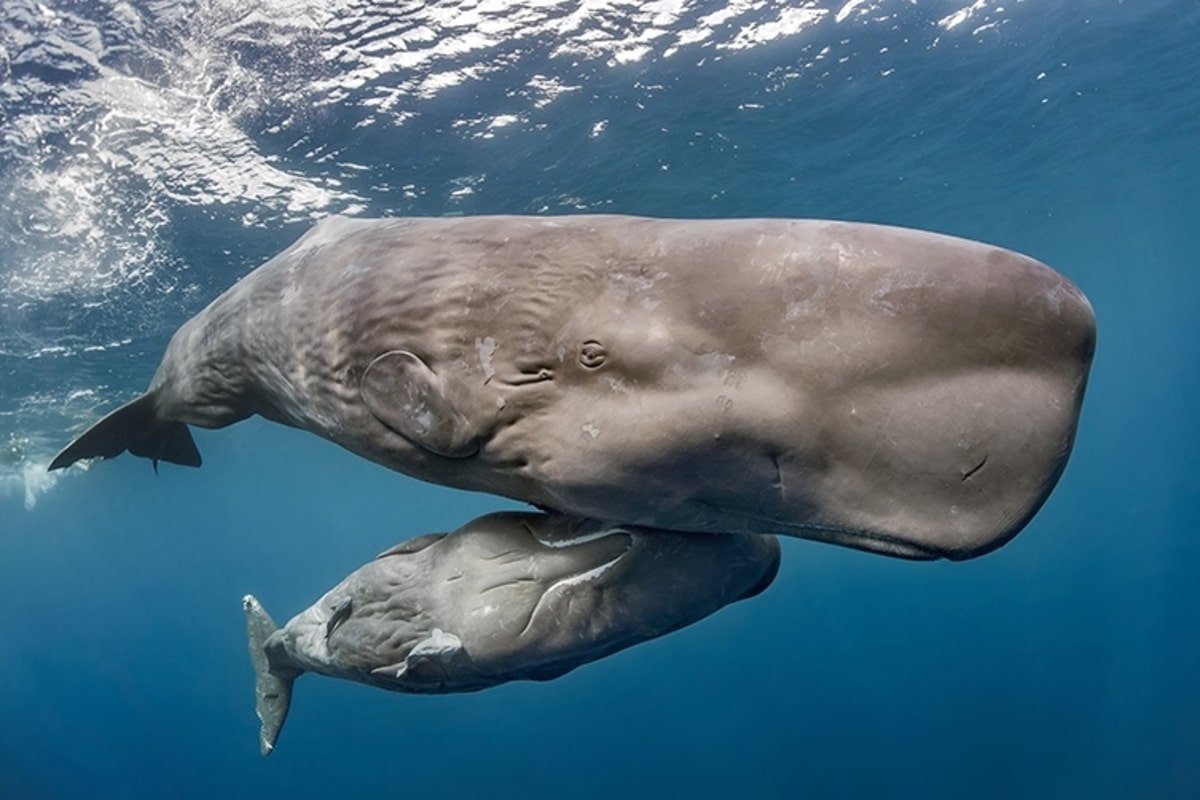Sperm whales are among the most mysterious marine creatures, and much about them remains unknown. These massive mammals impress not only with their size but also with their astonishing abilities that continue to surprise scientists. Their behavior, anatomy, and methods of communication reveal many fascinating facts you might not be aware of. Exploring the world of sperm whales gives us a deeper understanding of the complexity and beauty of ocean life. Here are the most interesting and lesser-known facts about these remarkable animals.
- Sperm whales have the largest brain of any animal that has ever lived on Earth. It can weigh up to 9 kilograms, and the number of neurons in the cerebral cortex is extraordinary. This indicates their advanced capacity for learning, memory, and social interaction. Some researchers believe sperm whales may possess the rudiments of culture.
- They can dive to depths of over 2,000 meters in search of food. During such dives, a sperm whale can stay underwater for up to 90 minutes. This makes them one of the deepest-diving mammals in the world. Their bodies are uniquely adapted to withstand the extreme pressure, including the ability to slow their heart rate.
- The primary diet of sperm whales consists of giant squids, which they hunt at great depths. Their stomachs often contain remains of such squids, including large beaks. These battles can be so intense that scars from tentacle strikes remain on the whale’s skin. Some squids can reach up to half the length of the whale.
- The head of the sperm whale contains a large chamber filled with spermaceti, a substance that plays a key role in echolocation. This organ enables the whale to navigate and locate prey in the pitch darkness of the deep ocean. The name spermaceti originated from the mistaken belief that the substance was sperm. In reality, it is a waxy oil that changes density with temperature.
- A sperm whale’s echolocation is so powerful that its sound pulses can stun or even kill small fish. The frequency and strength of these signals surpass those of any sonar technology created by humans. The sounds can be heard from hundreds of kilometers away. This system allows the whale to hunt effectively even in total darkness.
- Sperm whales live in complex social structures, often forming groups of several dozen individuals. These groups have role distribution and even cooperative care for calves. Female whales frequently watch over each other’s young, taking turns in caregiving. Such behavior shows a high level of social intelligence.
- Despite weighing up to 50 tons, sperm whales move through water with incredible grace and quietness. Their fins and streamlined body minimize water resistance. This allows them to approach prey unnoticed. They can migrate thousands of kilometers across oceans.
- Sperm whales produce complex vocalizations in the form of clicks and patterned sequences of sound. These vocalizations vary between groups and have structured patterns. Scientists refer to them as dialects, suggesting the existence of a primitive language. This opens up new opportunities for studying animal communication.
- Male sperm whales are much larger than females and tend to lead more solitary lives. They typically join groups only during mating seasons. For the rest of the time, they dwell in colder northern waters. This behavioral model is common among many marine mammals.
- Ambergris, produced in the stomach of sperm whales, is one of the most valuable substances used in perfumery. It is a hard, waxy material that forms around undigested squid parts. Its scent is so prized that a single piece of ambergris can be worth tens of thousands of dollars. Sometimes it is found washed ashore after storms.
- A newborn sperm whale can weigh up to a ton and measure 4 to 5 meters in length. It feeds exclusively on its mother’s milk, which is extremely high in fat. The mother nurses her calf for several years until it can hunt on its own. This is another example of the strong parental care in these animals.
- Despite their strength, sperm whales have natural predators. Orcas are their main threat and may hunt in groups targeting young or weak whales. Adult sperm whales form protective circles around their calves to defend them. Such behavior reflects emotional bonds and instinctive defense mechanisms.
- Sperm whales can sleep vertically in the water, floating motionless with their heads pointing upwards. In this position, they may remain still for 10 to 15 minutes. It is one of the most unusual sleeping methods among mammals. During sleep, only one hemisphere of the brain rests, while the other controls breathing.
- Sperm whales have 20 to 26 massive teeth only in the lower jaw, while the upper jaw has none or hidden ones. Each tooth can weigh up to one kilogram. However, they do not use these teeth for chewing. Instead, they swallow prey whole, and the teeth may be used for gripping or during fights.
- A sperm whale’s tail strike can generate enough force to capsize a boat. In the 19th century, there were documented cases of sperm whales attacking whaling ships. One such event inspired the novel “Moby-Dick.” This contributed to the legend of the sperm whale as a fearsome sea monster.
These amazing facts about sperm whales reveal how fascinating and complex the world beneath the waves truly is. These marine giants impress not only with their physical capabilities but also with their advanced behaviors that sometimes resemble human traits. Scientific research continues to uncover new aspects of their lives. Sperm whales remain a symbol of the mysterious and powerful force of nature hidden in the depths of the oceans.





